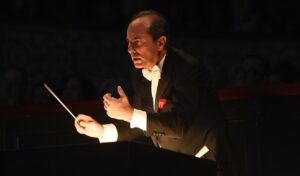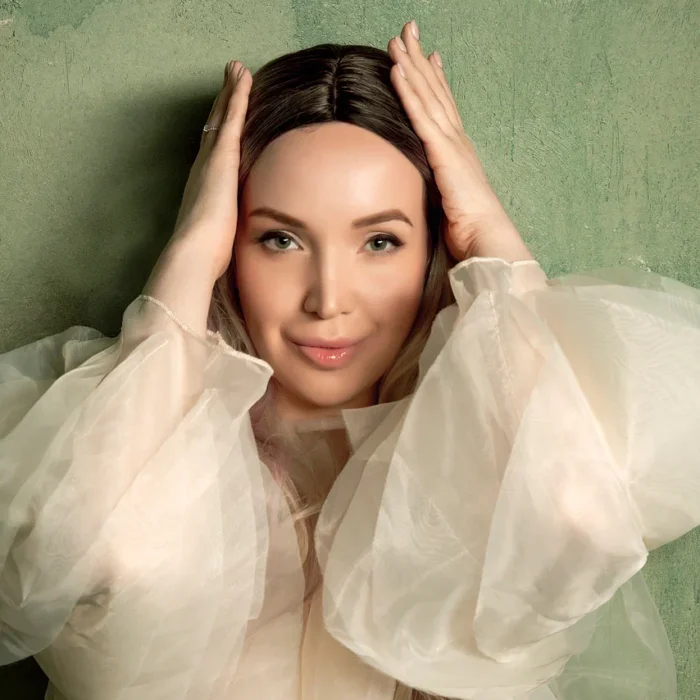
Q & A: Daniele Callegari on His Conducting Career & Approach to Verdi’s ‘Nabucco’
By Scott RoseItalian Maestro Daniele Callegari is scheduled to lead performances of Giuseppe Verdi’s “Nabucco” at The Metropolitan Opera this season, September through October 2023, and December through January 2024. The lead roles will be performed by George Gagnidze as Nabucco, Liudmyla Monastyrska as Abigaille, and Dmitry Belosselskiy as Zaccaria.
Callegari made his American debut in 2007, leading a concert performance of Tchaikovsky’s “The Maid of Orleans” at Carnegie Hall. Vivien Schweitzer of The New York Times wrote, “Callegari leapt around on the podium, slicing the air with his baton like a general spurring his troops into battle. The orchestra and chorale responded with feverish energy and delivered a bristling, explosive performance.”
“I Lombardi” is memorialized on a Unitel Classica DVD. On his opera blog, Dr. Neil Kurtzman wrote, “Much of the credit for the brilliance of this performance belongs to conductor Daniele Callegari. His tempi were right on the mark. The action never lagged. The chorus was taut. Callegari supported the principals without merely following them. Verdi’s operas all need a master behind the baton if they are to succeed. Callegari was the perfect Verdian.”
To judge by reviews Callegari has received for his performance of “Nabucco” in Wiesbaden, everybody who comes to the Metropolitan Opera to see him conduct this early Verdi score will emerge a winner. In the German language publication Main-Echo, Susanne von Mach wrote, “Beginning with his steady, clear interpretation of the Overture, conductor Daniele Callegari was warmly received. Nothing he does is for mere show; he emphasizes the soft and poignant beauty of the music. Thus did the third act’s famous ‘Va, pensiero’ chorus sound as though it were new and unfamiliar.”
In early September, OperaWire interviewed Maestro Callegari, in Italian, at the Met to learn more about his background and approach to Verdi’s “Nabucco.”
OperaWire: What do you want readers to know about your passion for conducting opera and especially “Nabucco”?
Daniele Callegari: This score is something I deeply cherish. When I was very young, I chose music as a vocation, the way somebody might decide to become a priest. At fourteen, I entered the Milan Conservatory. Fourteen years later, I earned my diploma in Orchestral Conducting. Meanwhile, though, I had already won several significant music prizes. And, at twenty two-years-old, I joined the Orchestra of La Scala, playing percussion and double bass with them for the next ten years.
The year 1983 marked my first opening night at La Scala, when I played under Lorin Maazel for “Turandot,” with Dimitrova, Domingo, and Ricciarelli. Watching Maazel, I was thunderstruck, and highly inspired. Right then, right there, I said to myself, ‘I absolutely must become an orchestra conductor.’
I had the great fortune of living through La Scala’s golden years. I heard so, so many marvelous singers, and played under so many extraordinary conductors. From each, I learned things of immense value to my own development. Imagine! I played under Bernstein. I played under Kleiber, Solti, Giulini, Sawallisch, Prêtre, Mehta, and Muti.
That was my real school. A regular school can give you a basic formation and teach you rudiments, but by playing in the opera house under all those great conductors, I absorbed a wealth of extraordinary musical and theatrical insights that no regular school could possibly have taught me.
OW: I recently observed Nello Santi’s conducting in a 1979 “Nabucco” video from the Paris Opera. What are your thoughts on Santi?
DC: You mention Nello Santi! Santi, like Giuseppe Patanè, is in a category of conductors that, I believe, the young people today don’t know. Nevertheless, those conductors are of the utmost importance to cultural history and especially to the cultural history of my country. I call them “unknown celebrities,” which I say in this sense; it’s much easier today to find people who know the name Andrea Bocelli. But, I’m talking about a time when the artisanship of music making was at a premium, when artistic substance was at a premium. I played under so many absolutely magnificent Italian conductors: Patanè, Gianandrea Gavazzeni, Armando Gatto!
OW: You currently live in Venice and your 2008 Metropolitan Opera debut was Ponchielli’s “La Gioconda.” Reviewing the Met performance for The Financial Times, Martin Bernheimer noted, “Callegari enforced both elegance and eloquence in the pit.” What are your thoughts?
DC: My wife and I both love beauty. I was born and raised in Milan, but I cannot live where there isn’t beauty. Venice, in my opinion, is the most beautiful city in the world. “La Gioconda” is the Venetian opera par excellence! And, it’s always brought me good luck. I first conducted “Gioconda” in the Teatro Ponchielli in Cremona, the composer’s home city. Every time I do it, studying the score anew, I find additional riches. And in my mind, I can go through all the opera’s prominent Venetian places, which I know intimately; the courtyard of the Doge’s Palace, the Ca’ d’Oro, and the Giudecca. I live the story of “La Gioconda” in the most Venetian of ways!
OW: When did you first hear “Nabucco”?
DC: That’s impossible for me to pinpoint, because “Va, pensiero” is part of our life’s blood as Italian musicians. I was as good as born with “Va, pensiero.” Naturally, we studied it at the conservatory, including in our choral practice sessions. Once I entered the conducting profession, though, I set myself the goal of conducting everything Giuseppe Verdi ever composed. To date, I’m up to 21 operas as well as the Requiem and the Four Sacred Pieces.
I first conducted “Nabucco” at the International May Festival in Wiesbaden, Germany in 2009. That was when I really studied the entire score in its finest detail. And it struck me, I hadn’t previously understood this, but “Nabucco” is a masterpiece! It is a masterpiece.
Of course, you should know that I’m a Verdi fundamentalist. I have a hard time saying anything bad about any of his less well-known operas, for example, “Alzira,” “Giovanna d’Arco,” or “La battaglia di Legnano.” In every single opera by Verdi, I find at the very least some embryos of new ideas that contribute significantly to the great man’s compositional evolution. I always liken Verdi’s total output to that of Gustav Mahler; to really understand the composer, you must know everything he wrote. Each work complements all the others.
In 1999, when I was going to conduct Verdi’s first stage work “Oberto,” I posed myself the following question: How should I conduct this opera? Opening the score, at first blush it seems to have the imprint of the Bel Canto period. But then I realized, I simply could not think of it as being in the mold of a Donizetti opera. I couldn’t think of it as a clone of some other composer like Rossini or Bellini. In the end I understood, I must think of this as Verdi. So, I gave my interpretation of “Oberto” a Verdian accent. I believe it worked well.
In the case of “Nabucco,” we all know that the score came perilously close to never being composed. Having lost his first wife and two children in quick succession, and with his first two operas “Oberto” and “Un giorno di regno” unsuccessful, Verdi was depressed, and had arduously to be talked into attempting to compose another opera. But he overcame all his psychological obstacles and had the great inspiration that led to this score. And, I say this all the time, I am forever grateful to him. Indeed, I’m given to thinking of Giuseppe Verdi as my main employer.
OW: Which aspects of “Nabucco” do you think most distinguish it from Verdi’s first two operas?
DC: One of the most salient aspects is how Verdi inserts sections of a conspicuously new sort of verticality, orchestral masses sometimes combined with chorus, all moving implacably forward together in rhythm, giving the music more body, making it sound more virile, more marked and accentuated, at times even obsessive.
(Callegari starts animatedly and emphatically singing the Part one finale of the Hebrews, with Zaccaria, cursing Ismaele over his betrayal. “Oh, fuggite il maledetto”/Terra e cielo griderà.” Opening the full orchestral score to that spot at the end of Act one.)
You can see the Verdian verticality I’m talking about, no? Indeed, in the score, that verticality is as striking visually as it is aurally in the opera house. Then too, in my opinion, “the Verdi sound” is anything but that of a parade band. Some ill-informed commentators would have you believe that certain of Verdi’s music, especially early Verdi accompaniments, consist of banalities. How frequently have we heard such things said dismissively of Verdi’s so-called “Oom-pa-pa”? But what we all must understand and respect, is that in interpreting these works, those Verdi accompaniments must be played in ways that ennoble them.
(Often, when Callegari wants to emphasize a point, he repeats an idea, palpably savoring it. Here, he does that with the notion of ennobling Verdi’s accompaniments. “Va no-bi-li-TA-to!”)
Ennobled means that the music serves to underline the word, something which, by the way, Verdi carries through on all the way to “Falstaff” where the music is in service to the words just as much as the words are in service to the music. But, already in “Nabucco,” that starts being an unmistakable aspect of Verdi’s writing. So, lending a musical expression to what the words are saying is something that works “Verdianamente.” And, it works to such an extent that the success of “Nabucco” is tied to the phenomenon wherein certain parts of this opera, like “Va, pensiero,” remain impressed body and soul in all Italians.
To go on a little tangent, I’ve also conducted Bellini’s “I Capuletti ed i Montecchi,” an opera that I love alla follia. I would travel anywhere in the world – Anywhere! — to hear a good performance of it. Open the “Capuletti” score, and in many pages in the orchestra, what do you see? Pizzicati. Simple pizzicati, which somebody could mistake for an indifferently repetitive “ploom, ploom, ploom.” And if those pizzicati are played that way, “ploom, ploom, ploom,” with no meaning, then all anybody will ever hear is a banal “ploom, ploom, ploom.” But if the conductor has the time to carefully rehearse with the orchestra, explaining that specific pizzicati get played in specific, but varied ways, and why, then the pizzicati are ennobled and serve meaningfully to sustain a phrase or to underline a word in a particular manner so its significance reaches the public, creating an emotion.
Returning now to our Giuseppe Verdi, all thoughts that Verdi accompaniments should sound like parade band music must be eliminated. I repeat that in interpretation, these Verdi accompaniments have to be ennobled. In my opinion, this is essential in Verdi.
These things that look very easy to play, in fact require a lot of loving musical care and attention. Additionally, in Verdi, a conductor must understand exactly what is happening on the stage in order to create a seamless, continuous dialogue between the stage and the orchestra pit.
OW: What about Zaccaria’s vocal lines?
DC: Here at the Met, we have a marvelous Zaccaria in Dmitry Belosselskiy, who has an exceptional instrument. “Nabucco” offers up this type of basso profondo role that is very distinct from what came before. Think how different Zaccaria is from the main bass role in “La Sonnambula,” Il Conte Rodolfo. Here, with Zaccaria’s vocal lines, there is unprecedented substance as well as an imposing heft. Perhaps the musical phrases are less ample, less long-arching than in Bellini. But, along with the substance and heft there is greater incisiveness in his sung utterances. Then too, as Zaccaria most often is sonically surrounded by the chorus, he must have that kind of deep bass that really stands out and can be heard as a distinct, attention-riveting individual.
In “Nabucco,” with the role of Nabucco being a baritone, we observe the first of a monumental series of Verdi characters, with genius being lavished on the interplay between two deep male voices. This, too, carries all the way forward to “Falstaff,” with Falstaff and Ford. This great regard given to the lower voices is extremely Verdian.
Now looking at the ladies’ side, Abigaille is the first role to have this particular constellation of vocal challenges. It requires tremendous agility. And also great range, from very high to very low, and the voice must never disappear in producing those low notes. Then, Abigaille must be able to negotiate a lot of sudden, dramatic leaps. I return to what I keep saying, that each of Verdi’s operas opens doors to many later Verdi operas. Abigaille is a real pathbreaker. There are similar lead female roles in “Attila,” in “Macbeth,” and “I Lombardi alla prima crociata.” Dimitra Theodossiou, my Abigaille for the Wiesbaden “Nabucco,” was also my Giselda for an “I Lombardi” at the Teatro Regio di Parma. Giselda can, in many respects, be compared, vocally, to Abigaille. Plenty of very demanding dramatic passages, but then she also must be able to sing piano, and even with messa di voce.
OW: Callegari raises the topic of opera directors:
DC: It’s one thing if at times, an audience member is rude. But in this day and age, all too often we’re disturbed by the productions themselves. A production that isn’t well-thought-out can interfere with singers in rehearsal. Then too, if people come to the theater and see the Duke in a modern business suit and Gilda under a beach umbrella, how are they supposed to understand what’s happening in “Rigoletto”? Moreover, not that I saw it, but I’ve been told that in Berlin, there was a “Nabucco” with the chorus members dressed as bees, their wings aflutter.
(Callegari is referring to Hans Neuenfels’ controversial production of “Nabucco” for Die Deutsche Oper Berlin, which many in the audience greeted with angry howls and outraged Teutonic curses.)
I’ve been through it all, and then some. Of course, I won’t name names, but I’ve worked with directors who had only ever heard recordings with cuts. Cuts! In rehearsal, we come to a passage they don’t know, and they say, “What’s that music? I’ve never heard it before.” Then, there have also been those who ask questions like, “Do we really need that chorus there?” as if they knew better than the composer. Now, I’m not saying that we should never modernize. But, one must have the intelligence to know how to modernize. And not distort. Non stravolgere.
Fortunately, the Met’s Elijah Moshinsky production of “Nabucco” is, I know, very beautiful. I’ve been learning a lot about it these days in rehearsals.
OW: What about Verdi and the parola scenica?
DC: Verdi, had such strong theatrical instincts that everything in his works can be thought of as a parola scenica. Everything. “Fermate.” “Restate.” Each word must have its theatrical effect. Furthermore, I’ll tell you something about how I’ve been working during these “Nabucco” rehearsals. With the singers all together, not singling anybody out, I told them, “When you’re singing an aria, together we can find a tempo that works for both of us and that is ideal for your breath and your instrument. But where you must follow my precise indications are in the recitativi. That’s where not just the parola scenica but also the passo teatrale – theatrical pacing – are of prime importance. The audience must hear what the singers are saying, and the singers must respond to each other’s lines on time and in ways that make dramatic sense. Too long a pause can be the death of a scene.
OW: Will you do a “bis,” repeating the “Va, pensiero” chorus, even though doing so suspends the dramatic impetus to Zaccaria’s response to it? His stirring, motivational reproach to the ancient Hebrews for being too passive about their fate.
DC: I’ll gladly do a repeat, but it depends. If the audience is only mildly applauding, and at the beginning of the applause there is just one call of “Bis!” But nothing more, then I forge ahead in the opera. But if they are feverishly applauding and crying out “Bis! Bis! Bis!” then I say, “OK, you win.”



